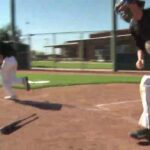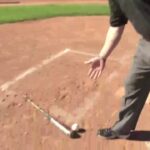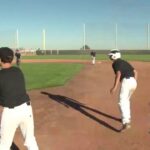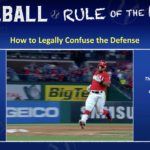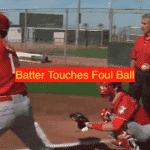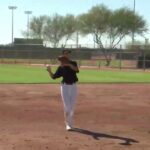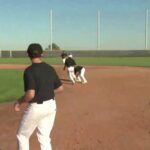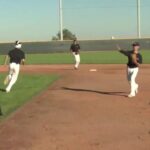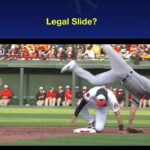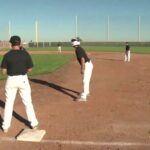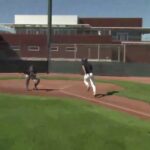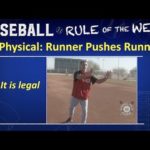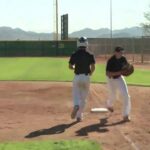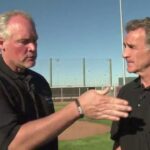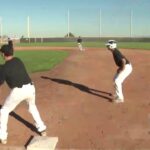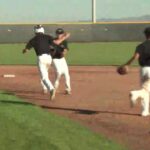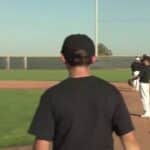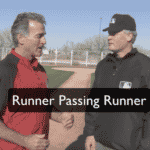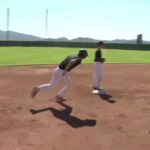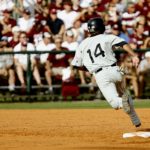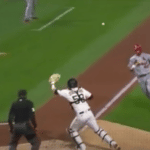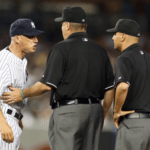Rule 8 – Section 4 – RUNNER IS OUT
8-4-1 The batter-runner is out when:
- he intentionally interferes with the catcher’s attempt to field the ball after a third strike;
- his fair hit or foul (other than a foul tip which is not a third strike) is caught by a fielder, or such catch is prevented by a spectator reaching into the playing field;
- his fair fly, fair line drive or fair bunt in flight is intentionally dropped by an infielder with at least first base occupied and before there are two outs. The ball is dead and the runner or runners shall return to their respective base(s).
- In this situation, the batter is not out if the infielder permits the fair fly, fair line drive or fair bunt in flight to drop untouched to the ground, except when the infield fly rule (2-19-1) applies (5-1-1j).
- after hitting or bunting a ball, he intentionally contacts the ball with the bat a second time in fair or foul territory. The ball is dead and no runner(s) advance.
- In the case of a foul ball, it must have a chance to become fair in the umpire’s judgment.
- If the bat and ball accidentally come in contact with each other a second time while the batter is holding the bat in the batter’s box, it is a foul ball.
- a third strike is caught by the catcher; or the third strike is not caught with first base occupied and there are less than two outs (2-16-2);
- after a dropped third strike (see 8-4-1e) or a fair hit, if the ball held by any fielder touches the batter before the batter touches first base; or if any fielder, while holding the ball in his grasp, touches first base or touches first base with the ball before the batter-runner touches first base: or
- he runs outside the three-foot running lane (last half of the distance from home plate to first base), while the ball is being fielded or thrown to first base; or
- This infraction is ignored if it is to avoid a fielder who is attempting to field the batted ball or if the act does not interfere with a fielder or a throw.
- The batter runner is considered outside the running lane lines if either foot is outside either line.
- any runner or retired runner interferes (2-21-1, 2-30-3) in a way which obviously hinders an obvious double play; or
- on a dropped third strike, he gives up by entering the bench or dugout area, or with two outs he does not attempt to reach first base before all infielders leave the diamond at the end of the half-inning;
- hits an infield fly and the infield-fly rule is in effect;
- enters the game as an illegal substitute and is discovered.
8-4-2 Any runner is out when he:
- runs more than three feet away from a direct line between bases to avoid being tagged or to hinder a fielder while the runner is advancing or returning to a base;
- This is not an infraction if a fielder attempting to field a batted ball is in the runner’s proper path and if the runner runs behind the fielder to avoid interfering with him.
- When a play is being made on a runner or batter-runner, he establishes his baseline as directly between his position and the base toward which he is moving.
- does not legally slide and causes illegal contact and/or illegally alters the actions of a fielder in the immediate act of making a play, or on a force play, does not slide in a direct line between the bases; or
- A runner may slide in a direction away from the fielder to avoid making contact or altering the play of the fielder.
- Runners are never required to slide, but if a runner elects to slide, the slide must be legal. (2-32-1, 2) Jumping, hurdling, and leaping are all legal attempts to avoid a fielder as long as the fielder is lying on the ground. Diving over a fielder is illegal.
PENALTY: The runner is out. Interference is called and the ball is dead immediately. On a force-play slide with less than two outs, the runner is declared out, as well as the batter-runner. Runners shall return to the bases occupied at the time of the pitch. With two outs, the runner is declared out. The batter is credited with a fielder’s choice.
- does not legally attempt to avoid a fielder in the immediate act of making a play on him; or
PENALTY: The runner is out, the ball remains live unless interference is called.
- dives over a fielder; or
PENALTY: The runner is out and the ball remains live unless interference occurs and is declared.
- initiates malicious contact;
- Malicious contact always supersedes obstruction. Runner(s) will be awarded appropriate base(s) per umpire’s judgment.
- as a runner or retired runner, fails to execute a legal slide, or does not attempt to avoid the fielder or the play on a force play at any base; or
- intentionally interferes with a throw or a thrown ball; or he hinders a fielder on his initial attempt to field a batted ball. A fielder is not protected, except from intentional contact if he misplays the ball and has to move from his original location; or his being put out is prevented by an illegal act by anyone connected with the team (2-21-1, 3-2-2, 3-2-3) or by the batter-runner; for runner returning to base (8-2-6); and for runner being hit by a batted ball (8-4-2k). If, in the judgment of the umpire, a runner including the batter-runner interferes in any way and prevents a double play anywhere, two shall be declared out (the runner who interfered and the other runner involved). If a retired runner interferes, and in the judgment of the umpire, another runner could have been put out, the umpire shall declare that runner out. If the umpire is uncertain who would have been played on, the runner closest to home shall be called out; or
- If two fielders try to field a batted ball and the runner contacts one or both, the umpire shall decide which one is entitled to field the ball and that fielder only is entitled to protection. If a fielder drops a batted ball and contact with a runner occurs during a subsequent attempt to field the ball, the fielder has the greater responsibility for avoiding contact.
- is touched by a live ball securely held by a fielder or is touched by a fielder’s glove or hand with the live ball held therein, while the runner is not touching his base.
- If a batter-runner safely touches first base and then overslides or overruns it, except on a base on balls, he may immediately return to first base without liability of being tagged out, provided he did not attempt to run or feint to second. Also, if any base comes loose from its fastening when any runner contacts it, such runner cannot be tagged out because the base slides away from him.
- The ball is not securely held if it is dropped or juggled after the runner is touched.
- does not retouch his base before a fielder tags him out or holds the ball while touching such base after any situation (8-2-1, 2-3 and 2-4). Umpire may also call him out at end of playing action upon proper and successful appeal. Also, it is not necessary for runner to retouch his base after a foul tip (2-16-2); or
- fails to reach the next base before a fielder either tags the runner out or holds the ball while touching such base, after runner has been forced from the base he occupied because the batter became a runner (with ball in play) when other runners were on first base, or on first and second, or on first, second and third. There shall be no accidental appeals on a force play.
- No runner may be forced out if a runner who follows him in the batting order is first put out (including a batter-runner who is out for an infield fly).
- is contacted by a fair batted ball before it touches an infielder, or after it passes any infielder, except the pitcher, and the umpire is convinced that another infielder has a play (5-1-1f, 6-1-5).
- If a runner is touching his base when he is hit by an infield fly, he is not out, but the batter is out by the infield fly rule. The ball is dead, even in the exception.
- If a runner is hit by an infield fly when he is not touching his base, both he and the batter are out.
- attempts to advance to home base when the batter interferes with a play at home base, with less than two outs; or
- If there are two outs, the batter is out because of his interference and since he is the third out, the runner cannot score. But if there are not two outs, the runner is out and the batter is not penalized.
- passes an unobstructed preceding runner before such runner is out (including awarded bases); or
- runs bases in reverse to confuse opponents or makes a travesty of the game; or
- positions himself behind a base to get a running start; or
- after at least touching first base, leaves the baseline, obviously abandoning his effort to touch the next base; or
NOTE: Any runner, after reaching first base, who leaves the baseline heading for the dugout or his defensive position believing that there is no further play, shall be declared out if the umpire judges the act of the runner to be considered abandoning his efforts to run the bases.
- is on or beyond a succeeding base when the ball is declared dead (5-2-2b-1) after having left a base too soon on a caught fly ball, or he failed to touch a preceding base, or he continues and touches a succeeding base after the ball has become dead and the defense initiates a proper and successful appeal;
- deliberately knocks the ball from a fielder’s hand.
- is physically assisted by a coach. (3-2-2)



